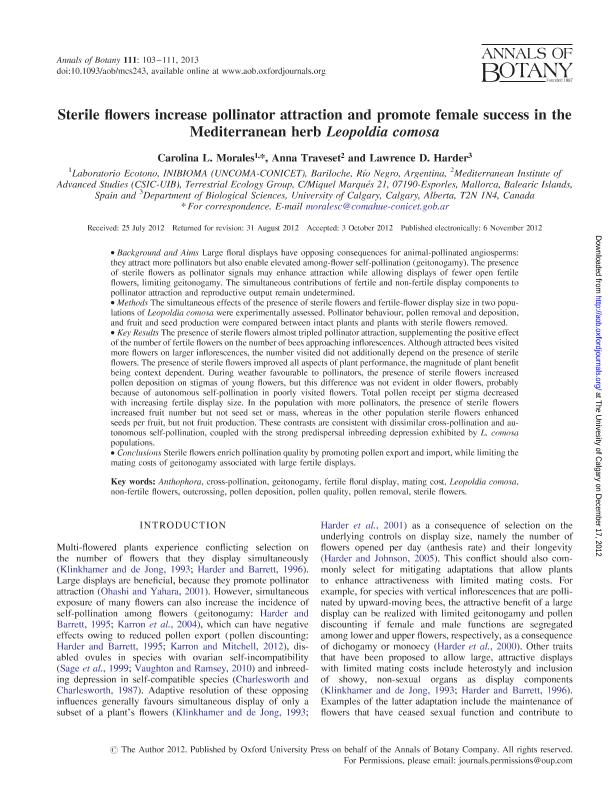Mostrar el registro sencillo del ítem
dc.contributor.author
Morales, Carolina Laura

dc.contributor.author
Traveset, Anna
dc.contributor.author
Harder, Lawrence D.
dc.date.available
2016-07-26T20:06:02Z
dc.date.issued
2013-01
dc.identifier.citation
Morales, Carolina Laura; Traveset, Anna; Harder, Lawrence D.; Sterile flowers increase pollinator attraction and promote outcrossing in the Mediterranean herb Leopoldia comosa; Oxford University Press; Annals of Botany; 111; 1; 1-2013; 103-111
dc.identifier.issn
0305-7364
dc.identifier.uri
http://hdl.handle.net/11336/6709
dc.description.abstract
Background and Aims Large floral displays have opposing consequences for animal-pollinated angiosperms: they attract more pollinators but also enable elevated among-flower self-pollination (geitonogamy). The presence of sterile flowers as pollinator signals may enhance attraction while allowing displays of fewer open fertile flowers, limiting geitonogamy. The simultaneous contributions of fertile and non-fertile display components to pollinator attraction and reproductive output remain undetermined.
Methods The simultaneous effects of the presence of sterile flowers and fertile-flower display size in two populations of Leopoldia comosa were experimentally assessed. Pollinator behaviour, pollen removal and deposition, and fruit and seed production were compared between intact plants and plants with sterile flowers removed.
Key Results The presence of sterile flowers almost tripled pollinator attraction, supplementing the positive effect of the number of fertile flowers on the number of bees approaching inflorescences. Although attracted bees visited more flowers on larger inflorescences, the number visited did not additionally depend on the presence of sterile flowers. The presence of sterile flowers improved all aspects of plant performance, the magnitude of plant benefit being context dependent. During weather favourable to pollinators, the presence of sterile flowers increased pollen deposition on stigmas of young flowers, but this difference was not evident in older flowers, probably because of autonomous self-pollination in poorly visited flowers. Total pollen receipt per stigma decreased with increasing fertile display size. In the population with more pollinators, the presence of sterile flowers increased fruit number but not seed set or mass, whereas in the other population sterile flowers enhanced seeds per fruit, but not fruit production. These contrasts are consistent with dissimilar cross-pollination and autonomous self-pollination, coupled with the strong predispersal inbreeding depression exhibited by L. comosa populations.
Conclusions Sterile flowers enrich pollination quality by promoting pollen export and import, while limiting the mating costs of geitonogamy associated with large fertile displays.
dc.format
application/pdf
dc.language.iso
eng
dc.publisher
Oxford University Press

dc.rights
info:eu-repo/semantics/openAccess
dc.rights.uri
https://creativecommons.org/licenses/by-nc-sa/2.5/ar/
dc.subject
Anthophora
dc.subject
Geitonogamy
dc.subject
Mating Cost
dc.subject
Pollen Deposition
dc.subject
Pollen Quality
dc.subject
Pollen Removal
dc.subject
Sterile Flowers
dc.subject
Leopoldia Comosa
dc.subject
Non-Fertile Flowers
dc.subject
Outcrossing
dc.subject
Fertile Floral Display
dc.subject
Cross-Pollination
dc.subject.classification
Ciencias de las Plantas, Botánica

dc.subject.classification
Ciencias Biológicas

dc.subject.classification
CIENCIAS NATURALES Y EXACTAS

dc.title
Sterile flowers increase pollinator attraction and promote outcrossing in the Mediterranean herb Leopoldia comosa
dc.type
info:eu-repo/semantics/article
dc.type
info:ar-repo/semantics/artículo
dc.type
info:eu-repo/semantics/publishedVersion
dc.date.updated
2016-07-22T18:53:33Z
dc.journal.volume
111
dc.journal.number
1
dc.journal.pagination
103-111
dc.journal.pais
Reino Unido

dc.journal.ciudad
Oxford
dc.description.fil
Fil: Morales, Carolina Laura. Consejo Nacional de Investigaciones Científicas y Técnicas. Centro Científico Tecnológico Patagonia Norte. Instituto de Investigación En Biodiversidad y Medioambiente; Argentina
dc.description.fil
Fil: Traveset, Anna. Consejo Superior de Investigaciones Científicas. Instituto Mediterráneo de Estudios Avanzados; España
dc.description.fil
Fil: Harder, Lawrence D.. University Of Calgary; Canadá
dc.journal.title
Annals of Botany

dc.relation.alternativeid
info:eu-repo/semantics/altIdentifier/url/http://aob.oxfordjournals.org/content/111/1/103
dc.relation.alternativeid
info:eu-repo/semantics/altIdentifier/doi/10.1093/aob/mcs243
dc.relation.alternativeid
info:eu-repo/semantics/altIdentifier/doi/http://dx.doi.org/10.1093/aob/mcs243
Archivos asociados
